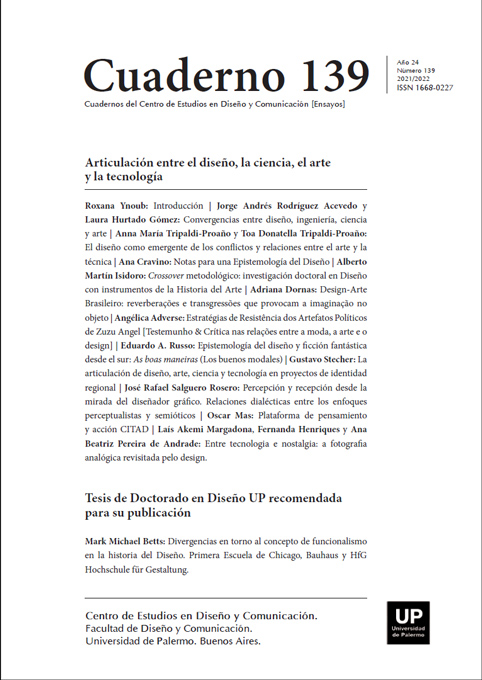Introducción
Abstract
The subject that motivates this publication began to be forged within the framework of the course ‘Epistemology of Design’, given at the PhD in Design at the University of Palermo. In this space we proposed to the students to explore, review, redefine and even "playfully intervene" the images shown below. The objective we were pursuing was to motivate reflection on the disciplinary fields and practices involved in them. The mentioned images were proposed by Rich Gold, in order to express the roles he had to play throughout his professional life. In the first one, Gold himself is represented with what he calls "the four caps of creativity", which, according to him, he had worn in his work as an artist, as a scientist, as a designer and as an engineer. Starting from them, he dwells on the distinctive –but also binding– features that he finds among the characters described. Then he represented Art, Design, Science and Engineering. The model can be read vertically and horizontally, resulting in different links between the contents of that diagram. In this publication, we propose, precisely, our own look at these motivating, and sometimes controversial, issues.
References
Costa, J. (s/f). Entrevista: “La eterna e inútil discusión: por qué el diseño no es arte?” Foro Alfa. Disponible en: https://foroalfa.org/articulos/la-eterna-e-inutil-discusion
Foerster, H.V. (2006) Las semillas de la Cibernética. Barcelona: Gedisa. Gadamer, Hans-Georg. 1993. Verdad y Método: Fundamentos de una hermenéutica filosófica. Salamanca: Sígueme.
Gibson, J. J. (1977). The theory of affordances.In R. Shaw & J. Bransford(Eds.), Perceiving, acting, and knowing: Toward an ecologicalpsychology (pp. 67-82).Hillsdale, NJ: Erlbaum. Gutiérrez-Pozo, A. El arte como realidad trasformada en su verdad. La rehabilitación hermenéutica de la estética en Hans-Georg Gadamer. Kriterion: Revista de Filosofia [online]. 2018, v. 59, n. 139 pp. 35-54. Disponible en: https://doi.org/10.1590/0100-512X2017n13902agp. ISSN 1981-5336.
Loewy, R. (1995) Lo feo no vende. Madrid: Ed. Iberia. López, Jesús. (2016). El legado de Henri Poincaré al siglo XX. Cuadernos del Cendes, 33(91), 143-145. Recuperado en 04 de junio de 2021, de http://ve.scielo.org/scielo.php?script=sci_arttext&pid=S1012-25082016000100010&lng=es&tlng=es
Maeda, J. (2006) El cuadrilátero de las Bermudas. Nota aparecida en blog personal. https://maeda.pm/2017/11/14/the-bermuda-quadrilateral-2006/
Maturana, H.; y Varela, F. (1994) De máquinas y seres vivos”. Santiago de Chile: Ed. Universitaria
Norman. D. (1999) Affordances, conventions and design Interactions, 6 (3), 38-43.
Oxman, N. (2016). Age of Entanglement.Journal of Design and Science.https://doi.org/10.21428/7e0583ad Poe, E. A., La filosofía de la composición, Premià, México, 1986.
Rich, G. (2009) La Plenitud. Creatividad, Innovación y hacer “cosas”. Barcelona, Gedisa. Samaja, Juan. (2003). Desafíos a la epidemiología (pasos para una epidemiología “Miltoniana”). Revista Brasileira de Epidemiologia, 6(2), 105-120. https://dx.doi.org/10.1590/S1415-790X2003000200005.
Ynoub, R. (2017) Prólogo. En Azaretto, C. (comp.) Investigar en Arte. La Plata: Editorial de la Universidad Nacional de La Plata.
Los autores/as que publiquen en esta revista ceden los derechos de autor y de publicación a "Cuadernos del Centro de Estudios de Diseño y Comunicación", Aceptando el registro de su trabajo bajo una licencia de atribución de Creative Commons, que permite a terceros utilizar lo publicado siempre que de el crédito pertinente a los autores y a esta revista.


